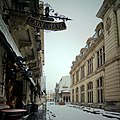 Lipscani Street during the winter of 2012 | |
| Former name(s) | Ulița Mare (Broad Lane) – until 1750[1] |
|---|---|
| Namesake | Leipzig |
| Length | 970 m (3,180 ft) |
| From | Anghel Saligny Street (Sector 5) |
| To | Calea Moșilor (Sector 3) |
| Construction | |
| Completion | 1589 |
| Other | |
| Known for | Nightlife |
| Status | Pedestrianised |
Lipscani is a street and a district of Bucharest, Romania, which from the Middle Ages to the early 19th century was the most important commercial area of the city and Wallachia. It is located near the ruins of the old Princely Court built by Vlad III the Impaler.[2][3]
History[edit]
It was named after Leipzig (Lipsca in 17th century Romanian), as that was the origin of many of the wares that could be found on the main street. The word lipscan (singular of lipscani) meant trader who brought his wares from Western Europe.
All trades were found in the area, including goldsmiths, hatters, shoemakers, tanners, saddlemakers, etc., many guilds (or isnafuri) having their own street: even nowadays, the nearby streets bear the name of a trade (Blănari = Furriers street, Șelari = Saddlemakers street, etc.).
During the Communist period, the whole area was scheduled to be demolished, but this never came to fruition. The district became neglected, but nowadays is the most attractive area for tourists of all Bucharest. As of 2013, many of the buildings were restored. In the early 21st century, much of the district has been transformed into a pedestrian zone.
Known mainly for its restaurants and bars, including the Caru' cu Bere, a few shops, that feel out of place such as H&M, Adidas and Yves Rocher, have begun to appear in the area, slowly turning Lipscani into a commercial shopping district as well.[4] One should pay attention to the architecture, the mix of neglected buildings and coquette facades but also to the uneven pavement. Even without high heels one risks to trip.
-
Carul cu Bere and Stavropoleos Church in the distance
-
Monument to Vlad the Impaler inside the Old Court
-
National Bank of Romania (old building)
-
Macca-Villacrosse Passage
-
Covaci Street
See also[edit]
References[edit]
- ^ Florin Stoican (1 May 2012). "Povești și legende din CENTRUL ISTORIC: raiul negustorilor, plăcinta cu carne de om și primii mititei din istorie". Adevărul (in Romanian).
- ^ "Gândul vă prezintă HARTA NOUĂ A CENTRULUI VECHI AL CAPITALEI: peste 140 de restaurante, baruri şi locuri de distracţie din cel mai nou pol de atracţie al Bucureștilor" (in Romanian). Gândul. 28 August 2011.
- ^ "Pe Lipscani, Crăciunul va fi ca la Viena. Iată de ce" (in Romanian). Realitatea TV. 19 November 2012. Archived from the original on 19 November 2012.
- ^ ""Lipscaniul va arăta în 2-3 ani ca o arteră de shopping. Peste 70% din spaţii vor fi ocupate de magazine". Barurile şi restaurantele vor pierde masiv teren | ZF Corporate".






